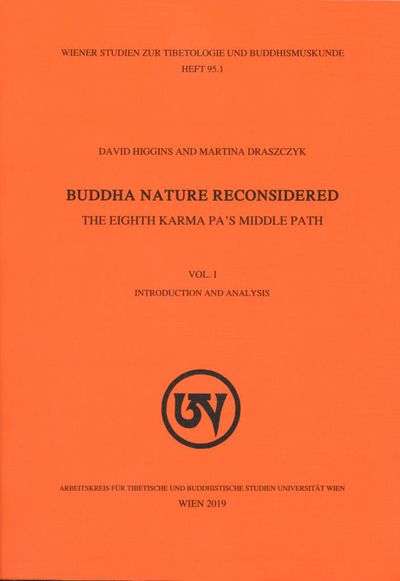Contents: Vol. 1
- Acknowledgements11
- Preface 13
- Chapter 1: Introduction 27
- Chapter 2: Doctrinal Background
- 1. Introductory remarks 57
- 2. An outline of buddha nature [by Karma phrin las], translation 60
- 3. Key points in Karma phrin las pa’s outline of buddha nature 72
- 3.1. Tathāgatagarbha concepts in early Indian Buddhist sources 72
- 3.2. Tathāgatagarbha concepts in Indo-Tibetan Mahāyāna sources73
- 3.3. Rang byung rdo rje’s Karma bka’ brgyud position on buddha
nature74 - 4. Critical edition of Karma phrin las pa’s outline of buddha nature78
- Chapter 3: The Eighth Karma pa’s Central Claims About Buddha Nature
- 1. Introductory remarks83
- 2. Sixteen central claims regarding buddha nature85
- 2.1. Buddha nature exists equally in everyone from ordinary beings to
buddhas85 - 2.2. Buddha nature discourses are of definitive meaning (nītārtha)95
- 2.3. The “nature” (garbha) of a buddha is actual, not nominal 101
- 2.4. The gotra is not metaphorical (upacāra), but attributions of cause
and result are106 - 2.5. Buddha nature is buddhahood obscured by defilements111
- 2.6. The three phases of buddha nature indicate progressive degrees of
disclosure116 - 2.7. The classification of three vehicles has a hidden intent (ābhiprāyika);
the one vehicle (ekayāna) doctrine is definitive (lākṣaṇika)120 - 2.8. The unfolded gotra is the naturally present gotra awakened through
virtue131 - 2.9. Resultant buddha nature may be equated with dharmakāya136
- 2.10. Buddha nature is not emptiness as a nonaffirming negation
(med dgag)141 - 2.11. Buddha nature is not a basis established (gzhi grub) by valid
cognition151 - 2.12. The identification of buddha nature and ālayavijñāna is
provisional162 - 2.13. Buddha nature is not a self (coarse or subtle) but is selflessness204
- 2.14. Buddha nature is only fully revealed in Mantrayāna thought and
praxis226 - 2.15. Buddha nature is natural awareness (tha mal gyi shes pa)241
- 2.16. Buddha nature consists in the unity of the two truths 257
- 3. Conclusion276
Contents: Vol 2
1. The Lamp of Fine Discernment Regarding the Tradition of the Gzhan
stong Madhyamaka Proponents
- 1.1. Introduction11
- 1.2. Annotated Translation: The Lamp of Fine Discernment Regarding the Tradition of the Gzhan stong Madhyamaka Proponents (Lamp)15
- 1.3. Critical Edition: Dbu ma gzhan stong smra ba 'i srol legs par phye ba 'i sgron me zhes bya ba bzhugs so ( LG)50
2. The Nerve Tonic for the Elderly
- 2.1. Introduction73
- 2.2. Annotated Translation: The Nerve Tonic for the Elderly, also known as The Sublime Fragrance of Nectar (Tonic)76
- 2.3. Critical Edition: Rgan po'i rlung sman, also known as Dpyad pa bdud dri mchog (GL)137
3. Buddha Nature and Dharmakāya
- 3.1. Introduction171
- 3.2. Annotated Translation: Buddha Nature and Dharmakāya: A Reply to Queries172
- 3.3. Critical Edition: Bde gshegs snying po dang chos sku'i dris lan174
4. Buddha Nature and Emptiness Imbued with Compassion
- 4.1. Introduction177
- 4.2. Annotated Translation of an Excerpt from Mi bskyod rdo rje's Single Intent Commentary (Intent) on 'Jig rten gsum mgon's Single Intent (Dgongs gcig) Vajra Precepts 1.27–28178
- 4.3. Critical Edition: Dgongs gcig kar ṭīg (GC) excerpt188
5. Buddha Nature and the Substratum
- 5.1. Introduction197
- 5.2. Annotated Translation of an Excerpt from Mi bskyod rdo rje's Single Intent Commentary on 'Jig rten gsum mgon's Single Intent Vajra Precept 8.36197
- 5.3. Critical Edition: Dgongs gcig kar ṭīg excerpt230
6. Buddha Nature and the Two Truths
- 6.1. Introduction to Excerpts [A-B] from Mi bskyod rdo rje's Explanation of the Direct Introduction to the Three Embodiments (Embodiments)255
- 6.2. Annotated Translation [A]: On the Unity of the Two Truths258
- 6.3. Critical Edition [A]: Sku gsum ngo sprod rnam bshad (KN) excerpt268
- 6.4. Annotated Translation [B]: On Buddha Nature in the Context of the Two Truths277
- 6.5. Critical Edition [B]: Sku gsum ngo sprod rnam bshad excerpt287
7. Buddha Nature and the Tantric Causal Continuum 7.1. Introduction to Excerpts [A-D] from Mi bskyod rdo rje's Explanation of the Direct Introduction to the Three Embodiments 295 7.2. Annotated Translation [A]: On the Connection Between the Three Continua 297 7.3. Critical Edition [A]: Sku gsum ngo sprod rnam bshad excerpt 305 7.4. Annotated Translation [B]: On the Refutation of Other Views of the Causal Continuum 312 7.5. Critical Edition [B]: Sku gsum ngo sprod rnam bshad excerpt 328 7.6. Annotated Translation [C]: On the Presentation of Our Own System 339 7.7. Critical Edition [C]: Sku gsum ngo sprod rnam bshad excerpt 345 7.8. Annotated Translation [D]: On the Purity of the Causal Continuum 347 7.9. Critical Edition [D]: Sku gsum ngo sprod rnam bshad excerpt 351 8. Buddha Nature and the Tantric Path Continuum 8.1. Introduction to Excerpts [A-B] from Mi bskyod rdo rje's Explanation of the Direct Introduction to the Three Embodiments 355 For Tsadra Internal Use Only 8.2. Annotated Translation [A]: On Buddha Nature's Inherent Qualities 357 8.3. Critical Edition [A]: Sku gsum ngo sprod rnam bshad excerpt 366 8.4. Annotated Translation [B]: On the Summary of the Creation and the Completion Stages 371 8.5. Critical Edition [B]: Sku gsum ngo sprod rnam bshad excerpt 377 9. Buddha Nature and the Tantric Resultant Continuum 9.1. Introduction 381 9.2. Annotated Translation: Excerpt on Buddha Nature, the Tantric Resultant Continuum from Mi bskyod rdo rje's Explanation of the Direct Introduction to the Three Embodiments 382 9.3. Critical Edition: Sku gsum ngo sprod rnam bshad excerpt 390 Bibliography Abbreviations of Collections, Editions, and Institutes 397 Primary Sources: Indian Works 397 Primary Sources: Tibetan Works 404 Secondary Sources 416 Index 433


